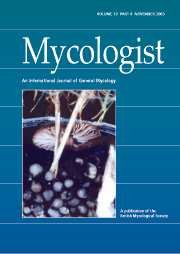Crossref Citations
This article has been cited by the following publications. This list is generated based on data provided by
Crossref.
Evans, H. C.
Holmes, K. A.
and
Reid, A. P.
2003.
Phylogeny of the frosty pod rot pathogen of cocoa.
Plant Pathology,
Vol. 52,
Issue. 4,
p.
476.
Leal Júnior, Gildemberg A
Duarte, Keila M. R
Albuquerque, Paulo S. B
Tavares, Flávio C. A
and
Figueira, Antonio
2005.
Produção de soros policlonais com alta afinidade contra o biotipo 'C' e o biotipo 'S' de Crinipellis perniciosa.
Fitopatologia Brasileira,
Vol. 30,
Issue. 5,
p.
482.
Krauss, Ulrike
Martijn ten Hoopen, G.
Hidalgo, Eduardo
Martínez, Adolfo
Stirrup, Tim
Arroyo, Claudio
García, Johnny
and
Palacios, Manuel
2006.
The effect of cane molasses amendment on biocontrol of frosty pod rot (Moniliophthora roreri) and black pod (Phytophthora spp.) of cocoa (Theobroma cacao) in Panama.
Biological Control,
Vol. 39,
Issue. 2,
p.
232.
Evans, Harry C.
2007.
Cacao Diseases—The Trilogy Revisited.
Phytopathology®,
Vol. 97,
Issue. 12,
p.
1640.
Phillips‐Mora, W.
Aime, M. C.
and
Wilkinson, M. J.
2007.
Biodiversity and biogeography of the cacao (Theobroma cacao) pathogen Moniliophthora roreri in tropical America.
Plant Pathology,
Vol. 56,
Issue. 6,
p.
911.
Formighieri, Eduardo F.
Tiburcio, Ricardo A.
Armas, Eduardo D.
Medrano, Francisco J.
Shimo, Hugo
Carels, Nicolas
Góes-Neto, Aristóteles
Cotomacci, Carolina
Carazzolle, Marcelo F.
Sardinha-Pinto, Naiara
Thomazella, Daniela P.T.
Rincones, Johana
Digiampietri, Luciano
Carraro, Dirce M.
Azeredo-Espin, Ana M.
Reis, Sérgio F.
Deckmann, Ana C.
Gramacho, Karina
Gonçalves, Marilda S.
Moura Neto, José P.
Barbosa, Luciana V.
Meinhardt, Lyndel W.
Cascardo, Júlio C.M.
and
Pereira, Gonçalo A.G.
2008.
The mitochondrial genome of the phytopathogenic basidiomycete Moniliophthora perniciosa is 109kb in size and contains a stable integrated plasmid.
Mycological Research,
Vol. 112,
Issue. 10,
p.
1136.
Schückel, Julia
Matura, Anke
and
van Pée, Karl-Heinz
2011.
One-copper laccase-related enzyme from Marasmius sp.: Purification, characterization and bleaching of textile dyes.
Enzyme and Microbial Technology,
Vol. 48,
Issue. 3,
p.
278.
Dand, Robin
2011.
The International Cocoa Trade.
p.
23.
Evans, H. C.
Bezerra, J. L.
and
Barreto, R. W.
2013.
Of mushrooms and chocolate trees: aetiology and phylogeny of witches' broom and frosty pod diseases of cacao.
Plant Pathology,
Vol. 62,
Issue. 4,
p.
728.
Bailey, Bryan A.
Crozier, Jayne
Sicher, Richard C.
Strem, Mary D.
Melnick, Rachel
Carazzolle, Marcelo F.
Costa, Gustavo G.L.
Pereira, Gonçalo A.G.
Zhang, Dapeng
Maximova, Siela
Guiltinan, Mark
and
Meinhardt, Lyndel
2013.
Dynamic changes in pod and fungal physiology associated with the shift from biotrophy to necrotrophy during the infection of Theobroma cacao by Moniliophthora roreri.
Physiological and Molecular Plant Pathology,
Vol. 81,
Issue. ,
p.
84.
Ali, Shahin S.
Melnick, Rachel L.
Crozier, Jayne
Phillips‐Mora, Wilberth
Strem, Mary D.
Shao, Jonathan
Zhang, Dapeng
Sicher, Richard
Meinhardt, Lyndel
and
Bailey, Bryan A.
2014.
Successful pod infections by Moniliophthora roreri result in differential Theobroma cacao gene expression depending on the clone's level of tolerance.
Molecular Plant Pathology,
Vol. 15,
Issue. 7,
p.
698.
Bailey, Bryan A.
Melnick, Rachel L.
Strem, Mary D.
Crozier, Jayne
Shao, Jonathan
Sicher, Richard
Phillips‐Mora, Wilberth
Ali, Shahin S.
Zhang, Dapeng
and
Meinhardt, Lyndel
2014.
Differential gene expression by Moniliophthora roreri while overcoming cacao tolerance in the field.
Molecular Plant Pathology,
Vol. 15,
Issue. 7,
p.
711.
Kües, Ursula
and
Navarro-González, Mónica
2015.
How do Agaricomycetes shape their fruiting bodies? 1. Morphological aspects of development.
Fungal Biology Reviews,
Vol. 29,
Issue. 2,
p.
63.
Kües, Ursula
2015.
From two to many: Multiple mating types in Basidiomycetes.
Fungal Biology Reviews,
Vol. 29,
Issue. 3-4,
p.
126.
Farfan, Ivan D. Barrero
De La Fuente, Gerald N.
Murray, Seth C.
Isakeit, Thomas
Huang, Pei-Cheng
Warburton, Marilyn
Williams, Paul
Windham, Gary L.
Kolomiets, Mike
and
Lukens, Lewis
2015.
Genome Wide Association Study for Drought, Aflatoxin Resistance, and Important Agronomic Traits of Maize Hybrids in the Sub-Tropics.
PLOS ONE,
Vol. 10,
Issue. 2,
p.
e0117737.
Ali, Shahin S.
Shao, Jonathan
Strem, Mary D.
Phillips-Mora, Wilberth
Zhang, Dapeng
Meinhardt, Lyndel W.
and
Bailey, Bryan A.
2015.
Combination of RNAseq and SNP nanofluidic array reveals the center of genetic diversity of cacao pathogen Moniliophthora roreri in the upper Magdalena Valley of Colombia and its clonality.
Frontiers in Microbiology,
Vol. 6,
Issue. ,
de Mattos-Shipley, K.M.J.
Ford, K.L.
Alberti, F.
Banks, A.M.
Bailey, A.M.
and
Foster, G.D.
2016.
The good, the bad and the tasty: The many roles of mushrooms.
Studies in Mycology,
Vol. 85,
Issue. ,
p.
125.
Bailey, Bryan A.
Ali, Shahin S.
Strem, Mary D.
and
Meinhardt, Lyndel W.
2018.
Morphological variants of Moniliophthora roreri on artificial media and the biotroph/necrotroph shift.
Fungal Biology,
Vol. 122,
Issue. 7,
p.
701.
Bailey, Bryan A.
Evans, Harry C.
Phillips‐Mora, Wilbert
Ali, Shahin S.
and
Meinhardt, Lyndel W.
2018.
Moniliophthora roreri, causal agent of cacao frosty pod rot.
Molecular Plant Pathology,
Vol. 19,
Issue. 7,
p.
1580.
Marelli, Jean-Philippe
Guest, David I.
Bailey, Bryan A.
Evans, Harry C.
Brown, Judith K.
Junaid, Muhammad
Barreto, Robert W.
Lisboa, Daniela O.
and
Puig, Alina S.
2019.
Chocolate Under Threat from Old and New Cacao Diseases.
Phytopathology®,
Vol. 109,
Issue. 8,
p.
1331.


